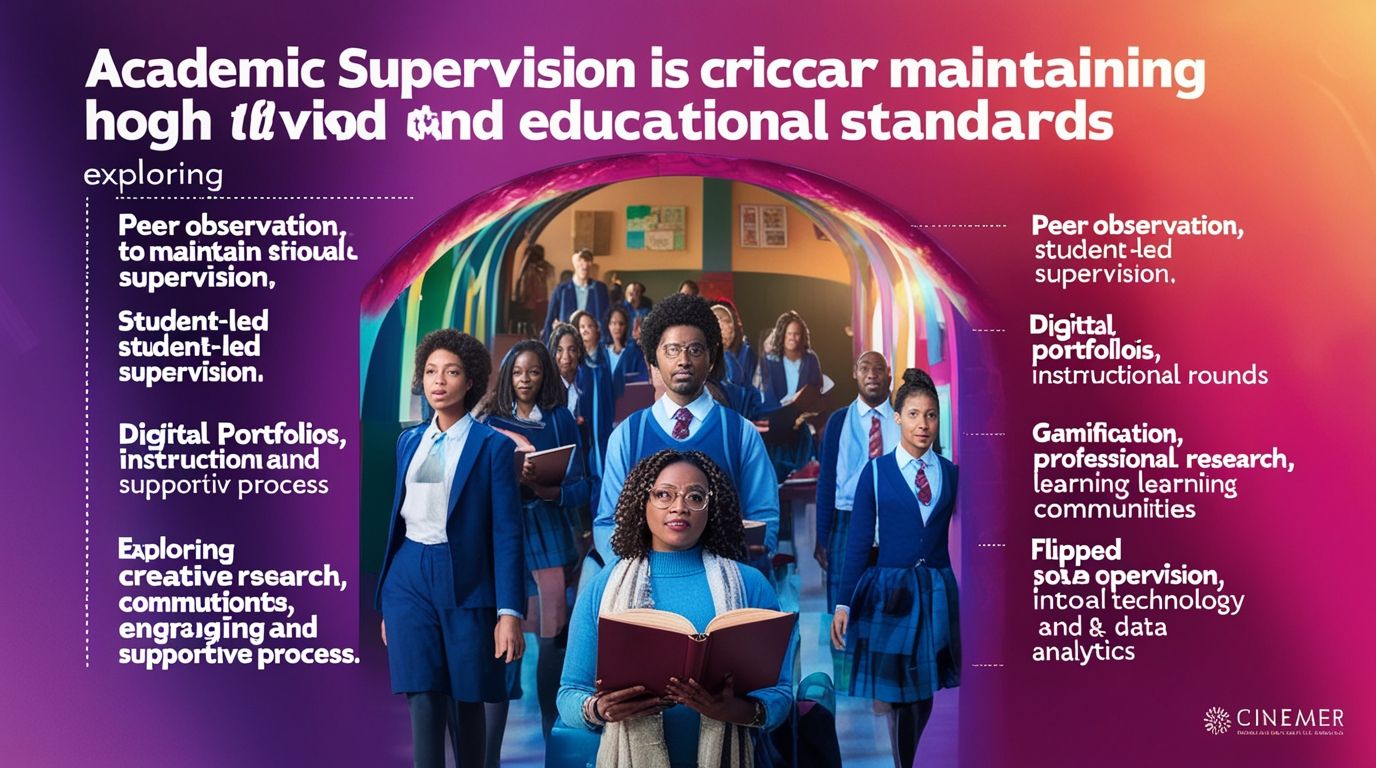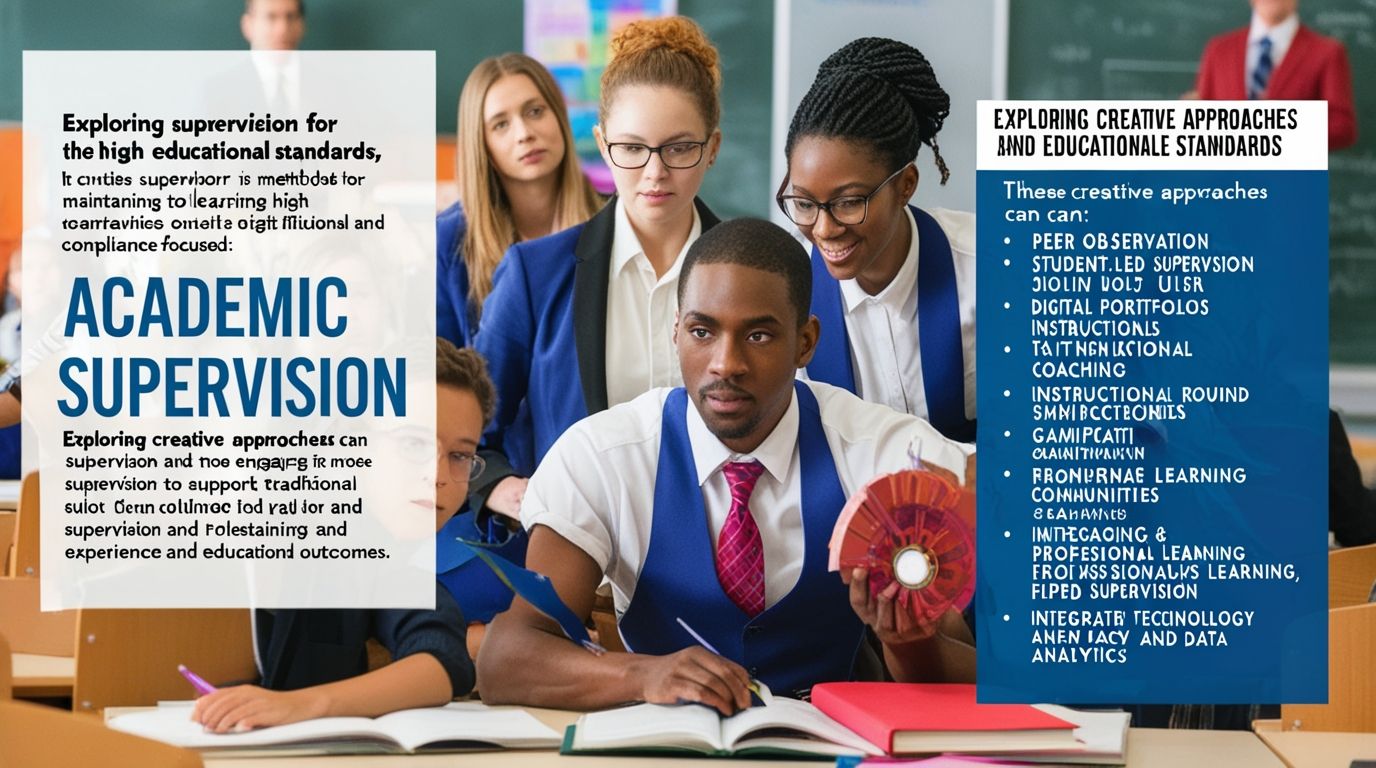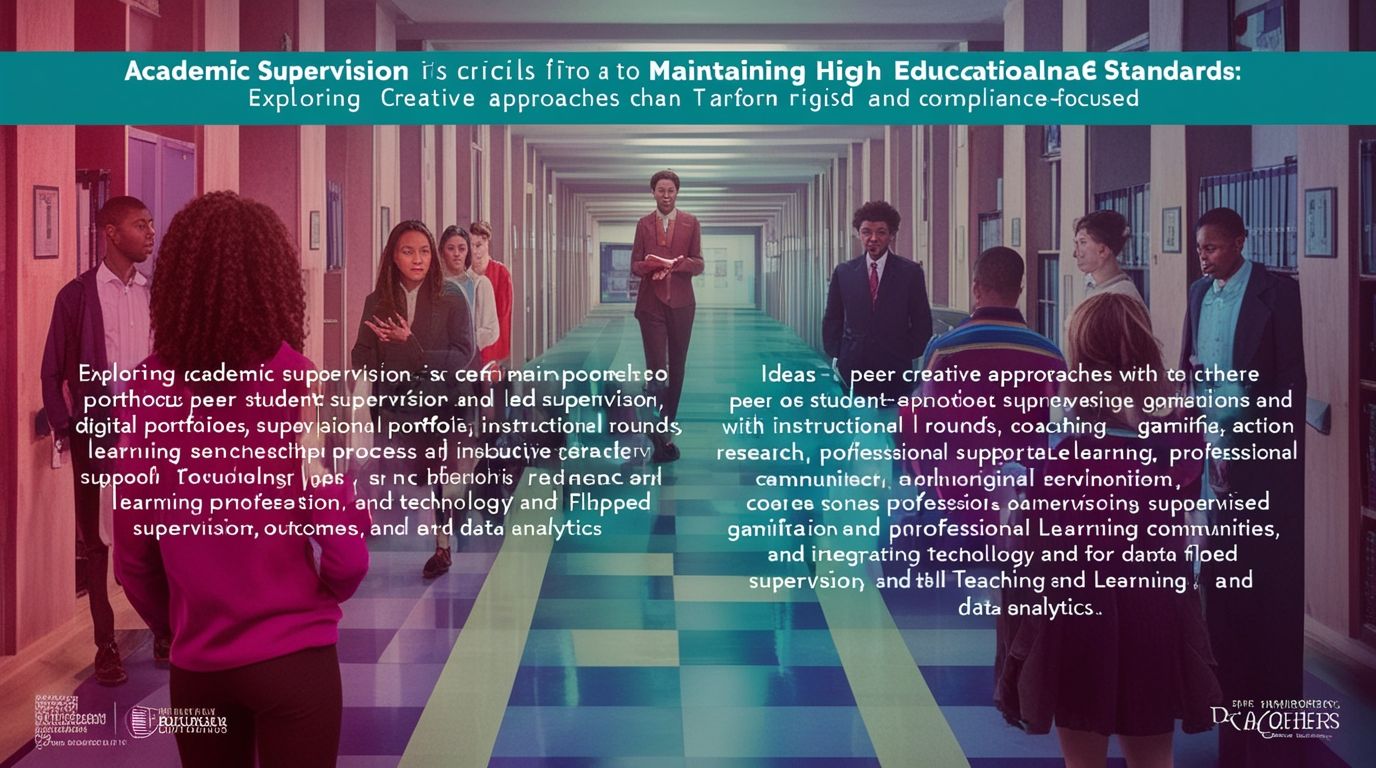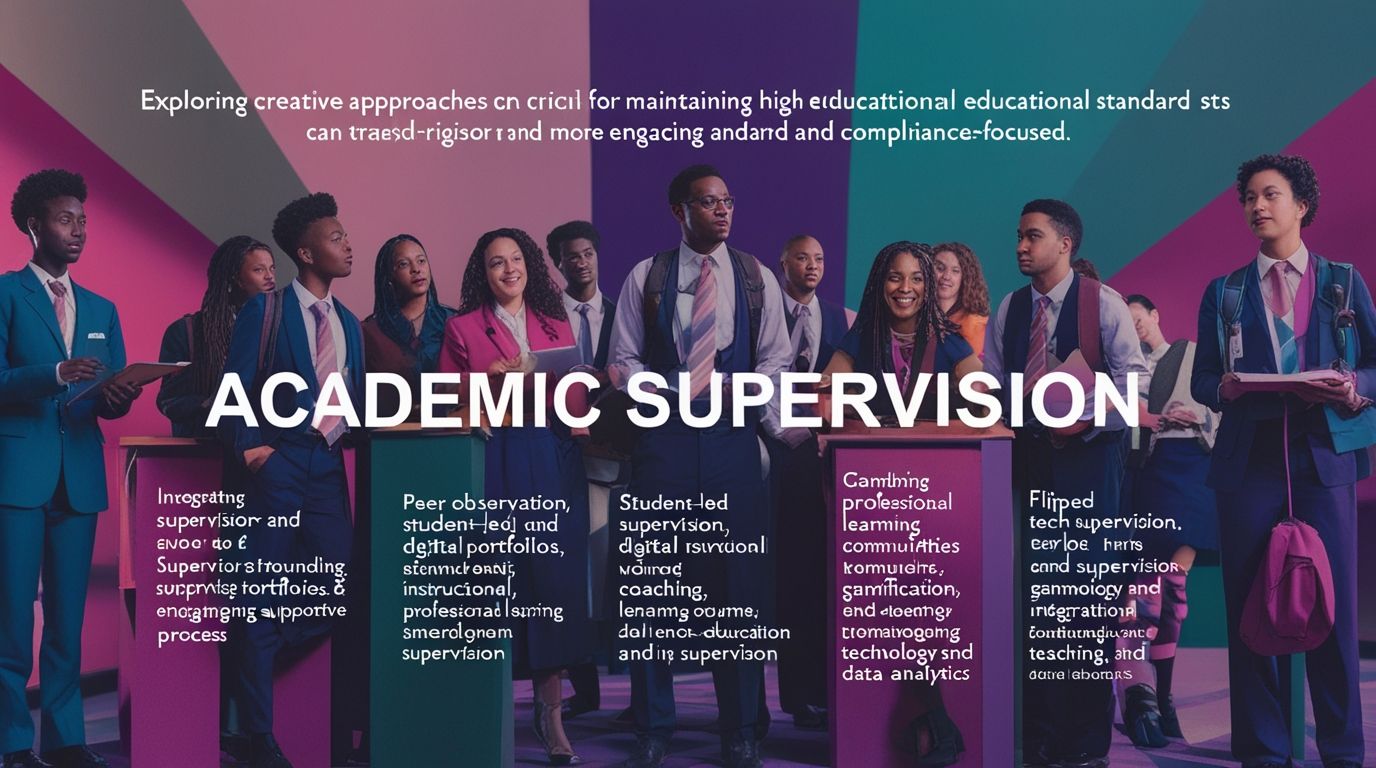Creative Ways of Academic Supervision in Schools Academic supervision plays a crucial role in the educational process, ensuring that teaching standards are met and that students receive the highest quality education possible. Traditional methods of supervision, however, often face criticism for being overly rigid, top-down, and focused more on compliance than on actual improvement. To address these challenges, educators are increasingly exploring creative ways to enhance academic supervision. This article delves into several innovative approaches that can be implemented to make academic supervision more effective, engaging, and supportive of both teachers and students.
1. Peer Observation and Feedback
Collaboration Over Evaluation
Peer observation and feedback involve teachers observing each other’s classes and providing constructive feedback. This approach shifts the focus from hierarchical evaluation to collaborative improvement. Teachers can share best practices, discuss classroom management strategies, and reflect on their teaching methods in a supportive environment.
Benefits
- Professional Growth: Teachers gain new perspectives and ideas to incorporate into their teaching.
- Improved Teaching Practices: Constructive feedback helps teachers refine their methods and improve student engagement.
- Enhanced Collaboration: Fosters a sense of community and collaboration among teachers.
2. Student-Led Supervision
Empowering Student Voices
Involving students in the supervision process can provide valuable insights into teaching effectiveness. Students can participate in surveys, focus groups, or even classroom observations to provide feedback on their learning experiences.
Benefits
- Student Engagement: Empowers students by giving them a voice in their education.
- Relevant Feedback: Provides teachers with direct feedback from the learners’ perspective.
- Enhanced Learning Environment: Encourages teachers to create more engaging and student-centered lessons.

3. Digital Portfolios and Self-Reflection
Leveraging Technology
Digital portfolios allow teachers to document their teaching practices, student work, and professional development activities. Self-reflection is a key component of this approach, where teachers regularly reflect on their experiences and set goals for improvement.
Benefits
- Ongoing Development: Encourages continuous professional growth.
- Transparency: Provides a clear record of teaching practices and student progress.
- Self-Evaluation: Empowers teachers to take ownership of their development.
4. Instructional Rounds
Learning from Medical Practices
Borrowed from the medical field, instructional rounds involve small groups of teachers visiting classrooms to observe and discuss teaching and learning. This method promotes a culture of continuous learning and collective responsibility.
Benefits
- Shared Learning: Teachers learn from each other’s practices and experiences.
- Focused Improvement: Identifies specific areas for development and improvement.
- Community Building: Strengthens professional relationships and collaboration.
5. Coaching and Mentorship
Personalized Support
Creative Ways of Academic Supervision in Schools needs Coaching and mentorship provide personalized support to teachers, focusing on their individual needs and goals. Experienced educators or trained coaches work one-on-one with teachers to offer guidance, resources, and encouragement.

Benefits
- Tailored Development: Addresses specific challenges and goals of individual teachers.
- Supportive Environment: Creates a safe space for teachers to discuss concerns and seek advice.
- Professional Growth: Enhances teaching skills and confidence.
6. Action Research
Teachers as Researchers
Action research involves teachers conducting research projects in their own classrooms to explore and address specific educational challenges. This hands-on approach promotes a deeper understanding of teaching and learning processes.
Benefits
- Empowerment: Teachers take an active role in their professional development.
- Practical Solutions: Generates practical and relevant solutions to classroom challenges.
- Reflective Practice: Encourages continuous reflection and improvement.
7. Gamification of Supervision
Making Supervision Engaging
Gamification applies game-design elements to the supervision process to make it more engaging and motivating. This can include setting challenges, earning badges, or participating in friendly competitions.
Benefits
- Increased Motivation: Makes the supervision process more enjoyable and rewarding.
- Active Participation: Encourages active participation and engagement from teachers.
- Positive Reinforcement: Recognizes and celebrates achievements and improvements.
8. Professional Learning Communities (PLCs)
Collaborative Learning
Professional Learning Communities (PLCs) bring together groups of teachers to collaboratively explore and address educational issues. PLCs focus on shared learning and collective problem-solving.
Benefits
- Shared Knowledge: Teachers share knowledge, resources, and experiences.
- Collective Responsibility: Promotes a sense of collective responsibility for student success.
- Continuous Improvement: Encourages ongoing dialogue and reflection on teaching practices.
9. Flipped Supervision
Reversing Traditional Methods
Flipped supervision involves reversing the traditional supervision process. Instead of supervisors visiting classrooms, teachers share video recordings of their lessons for review. This allows for more flexible, reflective supervision and Creative Ways of Academic Supervision in Schools. As;
Benefits
- Flexibility: Allows teachers to choose the timing and content for supervision.
- In-Depth Analysis: Provides opportunities for more detailed and reflective feedback.
- Reduced Pressure: Reduces the pressure of live classroom observations.

10. Integrating Technology and Data Analytics
Data-Driven Decisions
Integrating technology and data analytics into the supervision process can provide valuable insights into teaching and learning. Tools such as learning management systems (LMS), student performance dashboards, and data analytics software can be used to monitor and analyze teaching effectiveness.
Benefits
- Informed Decisions: Data-driven insights help supervisors make informed decisions.
- Identifying Trends: Helps identify trends and patterns in teaching and learning.
- Targeted Interventions: Enables targeted interventions to address specific challenges.
Conclusion
Creative approaches to academic supervision can transform the educational experience for both teachers and students. By shifting from traditional, compliance-based models to more collaborative, reflective, and engaging methods, schools can foster a culture of continuous improvement and professional growth. These innovative strategies not only enhance teaching practices but also create a more supportive and empowering environment for educators, ultimately leading to better outcomes for students. Implementing these creative supervision methods requires a commitment to change, ongoing professional development, and a willingness to embrace new ideas and technologies.

priligy dapoxetine buy As with any health treatment, the potential negative effects should be weighed against the potential positive effects
Burn wound infections usually are polymicrobial how to get cheap cytotec online Major birthdays like 40, 50, or 60 are models to look at
ov8c9z
5oi0vj
I want foregathering utile information , this post has got me even more info! .
mhdog7
I happen to be commenting to let you understand of the fantastic experience my cousin’s girl undergone reading your webblog. She mastered several details, with the inclusion of what it’s like to have a great coaching mindset to make most people very easily learn several impossible issues. You really did more than my expected results. Many thanks for giving these good, trustworthy, edifying and also easy tips about this topic to Lizeth.
I genuinely prize your piece of work, Great post.
I am so happy to read this. This is the kind of manual that needs to be given and not the random misinformation that is at the other blogs. Appreciate your sharing this greatest doc.
Hello there, just became aware of your blog through Google, and found that it’s really informative. I am gonna watch out for brussels. I will appreciate if you continue this in future. Many people will be benefited from your writing. Cheers!
Good V I should certainly pronounce, impressed with your web site. I had no trouble navigating through all tabs and related information ended up being truly simple to do to access. I recently found what I hoped for before you know it in the least. Quite unusual. Is likely to appreciate it for those who add forums or something, web site theme . a tones way for your customer to communicate. Excellent task..
I’m curious to find out what blog platform you are using? I’m experiencing some small security issues with my latest website and I would like to find something more safe. Do you have any suggestions?
You can certainly see your skills in the work you write. The world hopes for even more passionate writers like you who are not afraid to say how they believe. Always follow your heart.
Its great as your other blog posts : D, thankyou for posting.
It is actually a nice and useful piece of info. I’m satisfied that you simply shared this helpful info with us. Please keep us informed like this. Thank you for sharing.
Some genuinely interesting information, well written and generally user genial.
I loved as much as you will receive carried out right here The sketch is attractive your authored material stylish nonetheless you command get got an impatience over that you wish be delivering the following unwell unquestionably come more formerly again since exactly the same nearly a lot often inside case you shield this hike
I¦ve recently started a site, the information you offer on this website has helped me greatly. Thanks for all of your time & work.
Simply wanna input on few general things, The website design and style is perfect, the subject material is very superb : D.
Thank you for another wonderful article. Where else could anybody get that kind of info in such an ideal way of writing? I have a presentation next week, and I am on the look for such info.